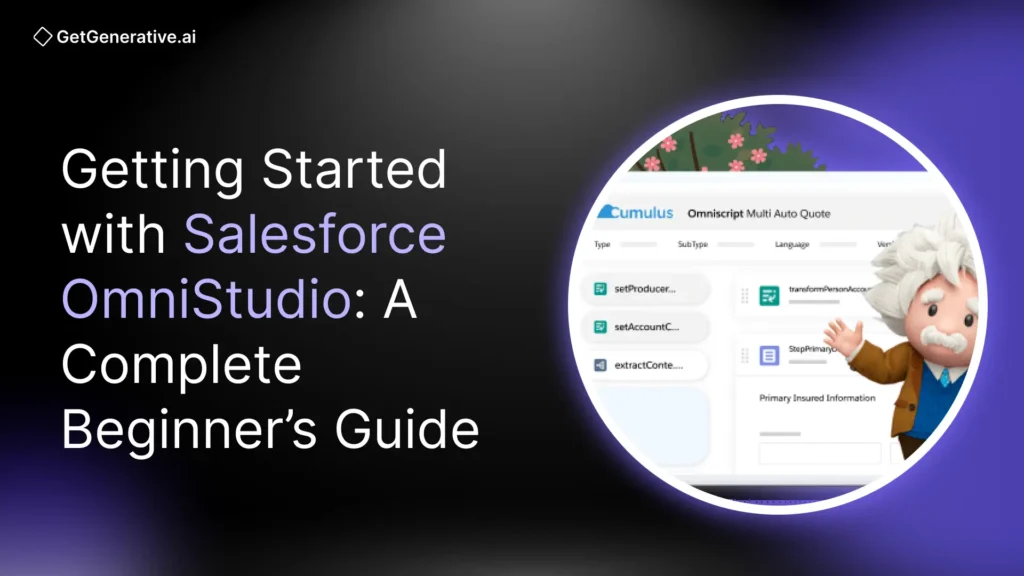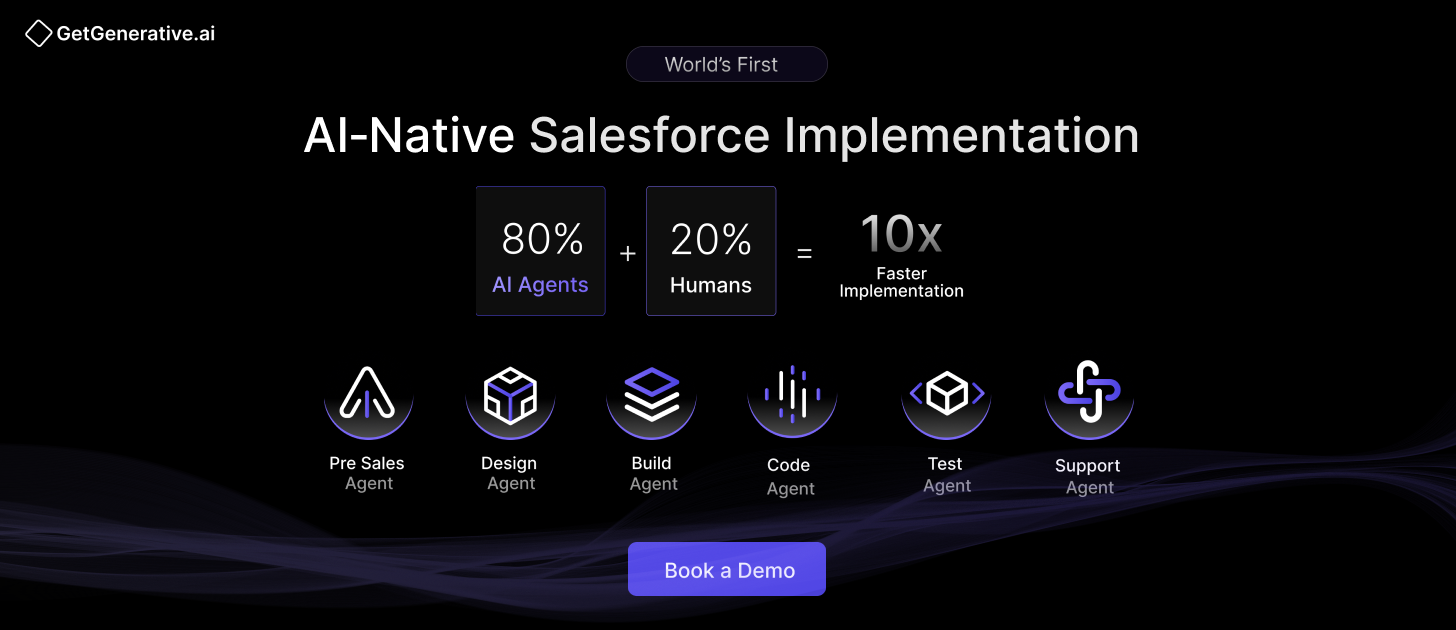Getting Started with Salesforce OmniStudio: A Complete Beginner’s Guide
Enterprises today face mounting pressure to innovate rapidly while keeping costs under control. Industry research suggests that a majority of application development is now shifting to low-code platforms, while most Fortune 500 companies already rely on Salesforce for customer relationship management.
The convergence of these two trends has created a transformative opportunity: Salesforce OmniStudio. It combines the power of Salesforce with cutting-edge low-code capabilities. Organizations using OmniStudio have reported faster development cycles and major reductions in implementation costs.
The results are compelling: higher sales productivity, improved marketing ROI, and lower support costs. With the low-code market projected to grow dramatically in the coming years, OmniStudio isn’t just a development tool — it’s a strategic enabler for digital transformation.
Understanding Salesforce OmniStudio: A Strategic Foundation
What is Salesforce OmniStudio?
Salesforce OmniStudio is a low-code/no-code platform that empowers businesses to build branded digital experiences quickly, without deep coding expertise. It originated from Vlocity, which Salesforce acquired in 2020, and has since become central to Salesforce’s industry-focused solutions.
At its core, OmniStudio provides a unified development environment for application design, workflow automation, data modeling, and integration. This eliminates reliance on multiple disconnected tools and bridges the gap between business requirements and IT execution.
Why OmniStudio Matters for Enterprises
Enterprises today face critical challenges:
- Many already use cloud technologies, yet still grapple with fragmented systems and slow development cycles.
- Manual processes and siloed platforms limit agility and scalability.
OmniStudio directly addresses these issues by offering:
- Accelerated Time-to-Market: Development cycles shrink from months to weeks, with some organizations reporting dramatic reductions in delivery times.
- Cost Efficiency: Implementations typically cost far less than traditional enterprise development projects.
- Business Agility: A modular design allows organizations to adapt workflows quickly, aligning with companies that prioritize process simplification.
Also Read – Salesforce OmniStudio Consultant: A Complete Guide 2025
Core Building Blocks of OmniStudio
OmniStudio’s power lies in its modular, component-driven architecture. The four key components are:
- FlexCards – Dynamic UI elements that surface contextual data from multiple sources in real time, enabling quick decisions.
- OmniScripts – Guided, multi-step workflows that streamline complex processes like customer onboarding or case management.
- Integration Procedures – Server-side data orchestration tools for API calls, transformations, and system-to-system communication.
- DataRaptor (Data Mapper) – ETL functionality for extracting, transforming, and loading data between Salesforce and external systems.
Together, these components allow enterprises to deliver user-friendly, scalable, and industry-tailored applications without heavy custom coding.
Market Dynamics: Why Low-Code Matters Now
The shift toward low-code is reshaping enterprise software development. The global low-code platform market has grown significantly and is forecast to expand at a rapid pace for the next decade.
Key drivers include:
- Developer Shortages: Many organizations adopt no-code tools to fill the talent gap.
- Digital Transformation: Direct investments in transformation continue to grow globally.
- Efficiency Pressures: Companies seek ways to accelerate development without increasing headcount.
Industry-Specific Applications
OmniStudio shines when applied to complex, regulated industries where speed, compliance, and experience are critical.
1. Financial Services
- Onboarding Automation: OmniScripts cut onboarding from days to hours while embedding KYC and compliance checks.
- Portfolio Management: FlexCards surface real-time financial data, risk profiles, and alerts for advisors.
- Compliance Reporting: Integration Procedures streamline regulatory reporting and auditing.
2. Healthcare
- Care Coordination: OmniScripts consolidate patient records into a single workflow for more informed care delivery.
- Patient Portals: FlexCards power portals that unify lab results, prescriptions, and scheduling in one view.
- Population Health: Integration Procedures drive analytics that identify high-risk patients and optimize resources.
3. Manufacturing & Supply Chain
- Maintenance Workflows: Guided OmniScripts standardize equipment servicing while capturing IoT-enabled diagnostics.
- Supply Chain Visibility: FlexCards deliver real-time dashboards of inventory, logistics, and supplier status.
- Quality Management: Automated workflows ensure compliance with global standards while reducing manual inspections.
Implementation Strategy and Best Practices
Strategic Planning and Organizational Readiness
OmniStudio implementations succeed when strategy and execution align:
- Executive Sponsorship: Clear leadership support with measurable KPIs (like development speed, adoption rates, and cost savings) ensures accountability.
- Change Management and Training: Continuous training is vital. OmniStudio blends business and IT roles, so teams must be upskilled on both process and platform.
- Governance Framework: Establishing naming conventions, version control, and documentation standards keeps implementations scalable and sustainable.
Technical Implementation Methodology
A structured, iterative approach is key:
- Requirements Analysis: Map current workflows, identify automation opportunities, and define integration needs before building.
- Phased Deployment: Start with smaller, high-impact projects to show quick wins and build confidence.
- Integration & Data Management: Use Integration Procedures for all Salesforce data calls, apply caching for high-use datasets, and rely on asynchronous processing for non-critical operations.
Performance and Scalability
Enterprises must plan beyond initial rollout:
- Reusability: Create shared libraries of FlexCards, OmniScripts, and Data Mappers to accelerate future projects.
- Environment Management: Use a minimum of three environments (development, QA, production) and adopt CI/CD pipelines with tools like Copado or Gearset.
- Performance Monitoring: Track adoption, error rates, and response times to identify optimization opportunities.
Also Read – How to Deploy OmniStudio Components in Salesforce: Step-by-Step Guide
Financial Considerations and ROI
Cost Structure
OmniStudio projects vary by complexity and scope:
- Licensing: Basic projects can start at modest costs, while enterprise deployments may reach six figures.
- Implementation Services: Standard projects may fall in the tens of thousands, while large-scale rollouts can exceed that significantly. Offshore or blended delivery models often reduce costs substantially.
- Ongoing TCO: Organizations should budget for user training, maintenance, and periodic upgrades. Many Salesforce projects deliver payback in just over a year and continue to generate ROI for several years afterward.
Measuring ROI
Enterprises adopting OmniStudio typically report:
- Productivity Gains: Process automation and intuitive UIs increase efficiency across departments.
- Revenue Growth: Marketing and sales teams often see higher conversion rates thanks to streamlined data integration.
- Cost Reductions: Support costs decline with self-service portals and automated workflows, while development costs drop compared to traditional coding.
A comprehensive ROI assessment should measure both:
- Quantitative Metrics: Cost savings, delivery speed, and reduction in support volume.
- Qualitative Benefits: Better customer satisfaction, stronger employee experience, and reduced risk exposure.
Competitive Landscape: OmniStudio vs. Alternatives
Key Low-Code Competitors
- Microsoft Power Platform: Well integrated with Microsoft tools, but lacks Salesforce-native depth.
- OutSystems: Strong for enterprise-scale apps, though CRM integration requires extra effort.
- Mendix: Offers solid governance and lifecycle management but is less strategic for Salesforce-heavy organizations.
- Oracle APEX: Works best in Oracle-focused environments, but offers limited flexibility across platforms.
OmniStudio’s Competitive Edge
OmniStudio is uniquely positioned because of:
- Native Salesforce Integration: Eliminates the need for complex connectors and ensures compliance with Salesforce’s security model.
- Industry Accelerators: Pre-built templates and processes for finance, healthcare, telecommunications, and more.
- Hybrid Flexibility: Combine low-code with Apex code and Lightning Web Components for advanced customizations.
This combination makes OmniStudio particularly valuable for enterprises already invested in Salesforce.
Also Read – Best AI Tools for Salesforce Proposal Generation
Future Trends and Strategic Implications
Emerging Technology Integration
- AI and Machine Learning: OmniStudio integrates with Salesforce Einstein, enabling predictive analytics and intelligent process automation.
- Advanced Analytics: Tighter connections with Tableau support deeper visualization and real-time business intelligence.
- IoT and Edge Computing: OmniStudio can ingest IoT data and connect to edge scenarios, extending its role in manufacturing and logistics.
Market Evolution
- Citizen Developers: A growing portion of non-IT professionals now create applications using low-code platforms. OmniStudio makes this easier while keeping alignment with Salesforce standards.
- Hybrid Work Models: The demand for automated workflows and collaboration tools continues to grow with distributed teams.
- Compliance-First Development: Industries like healthcare and finance benefit from OmniStudio’s built-in compliance and auditing features.
Conclusion
Salesforce OmniStudio is more than a set of tools — it’s a catalyst for digital transformation. By combining low-code agility with Salesforce’s market-leading ecosystem, it helps organizations innovate faster, lower costs, and remain adaptable in a competitive environment.
At GetGenerative.ai, we’ve reimagined Salesforce implementation—built from the ground up with AI at the core. This isn’t legacy delivery with AI added on. It’s a faster, smarter, AI-native approach powered by our proprietary platform.
👉 Explore our Salesforce AI consulting services




